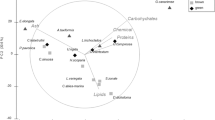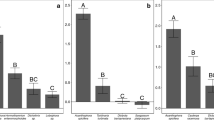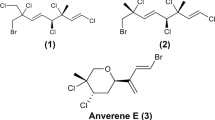Abstract
Brown seaweeds in the genus Dictyopteris produce several C11 sulfur metabolites that appear biosynthetically related to the C11 compounds known to attract sperm to female gametes of many brown algae. All four of the C11 sulfur compounds that we tested strongly deterred feeding by the amphipod Ampithoe longimana but had no effect on feeding by the sea urchin Arbacia punctulata, even when tested at concentrations that were two to eight times greater than those that deterred amphipods. In numerous previous investigations, a variety of seaweed compounds have been shown to deter feeding by large mobile herbivores such as fishes and urchins but to be relatively ineffective against mesograzers, such as the amphipod of our study. Our results for the C11 sulfur compounds from Dictyopteris thus contrast sharply with patterns from previous studies and suggest that these metabolites may be defenses specifically targeted against small mesograzers such as amphipods. The occurrence of C11 metabolites in brown algal eggs could allow these defenses to be especially important in defending gametes, zygotes, or young sporelings from herbivorous mesograzers.
Similar content being viewed by others
REFERENCES
Asato, A. E., and Moore, R. E. 1973. The synthesis of 3-n-hexyldithia-cycloheptan-5-one, a novel cyclic ketodisulfide from Dictyopteris. Tetrahedron Lett. 49:4941–4942.
Bell, S. S. 1991. Amphipods as insect equivalents? An alternative view. Ecology 72:350–354.
Boland, W. 1995. The chemistry of gamete attraction; chemical structures, biosynthesis and (a)biotic degradation of algal pheromones. Proc. Natl. Acad. Sci. U.S.A., 92:31–43.
Boland, W., and MÜller, D. G. 1987. On the odor of the Mediterranean seaweed Dictyopteris membranacea: New C11 hydrocarbons from marine brown algae. III. Tetrahedron Lett. 28:307–310.
Bousfield, E. L. 1973. Shallow-Water Gammaridean Amphipoda of New England. Cornell University Press, Ithaca, New York.
Brawley, S. H. 1992. Mesoherbivores, pp. 235–264, in D. M. John, S. S. Hawkins, and J. H. Price (eds.). Plant-Animal Interactions in the Marine Benthos, Systematic Association Special Volume. Clarendon Press, Oxford.
Carpenter, R. C. 1986. Partitioning herbivory and its effects on coral reef algal communities. Ecol. Monogr. 56:345–365.
Chapman, J. H., and Owen, L. N. 1950. Dithiols. Part IV. J. Chem. Soc. 579–589.
Cronin, G., and Hay, M. E. 1996a. Seaweed susceptibility to herbivores depends on recent history of both the plant and the animal. Ecology 77:1531–1543.
Cronin, G., and Hay, M. E. 1996b. Amphipod grazing and induction of seaweed chemical defenses. Ecology, 77:2287–2301.
Duffy, J. E., and Hay, M. E. 1990. Seaweed adaptation to herbivory. Bioscience 40:368–375.
Duffy, J. E., and Hay, M. E. 1991a. Food and shelter as determinants of food choice by an herbivorous marine amphipod. Ecology 72:1286–1298.
Duffy, J. E., and Hay, M. E. 1991b. Amphipods are not all created equal: A reply to Bell. Ecology 72:354–358.
Duffy, J. E., and Hay, M. E. 1994. Herbivore resistance to seaweed chemical defense: The role of mobility and predator risk. Ecology 75:1304–1319.
Faulkner, D. J. 1994. Marine natural products. Nat. Prod. Rep. 11:355–394.
Hay, M. E. 1991. Fish-seaweed interactions on coral reefs: effects herbivorous fishes and adaptations of their prey, pp. 96–119, in P. F. Sale (ed.). The Ecology of Fishes on Coral Reefs. Academic Press, San Diego, California.
Hay, M. E. 1992. The role of seaweed chemical defenses in the evolution of feeding specialization and in the mediation of complex interactions, pp. 93–118, in V. J. Paul (ed.). Ecological Roles of Marine Natural Products, Cornell University Press, Ithaca, New York.
Hay, M. E. 1996. Marine chemical ecology: What is known and what is next? J. Exp. Mar. Biol. Ecol. 200:103–134.
Hay, M. E. 1997. The ecology and evolution of seaweed-herbivore interactions on coral reefs. Coral Reefs. In press.
Hay, M. E., and Fenical, W. 1988. Marine plant-herbivore interactions: The ecology of chemical defense. Annu. Rev. Ecol. Syst. 19:111–145.
Hay, M. E., and Fenical, W. 1996. Chemical ecology and marine biodiversity: Insights and products from the sea. Oceanography 9:10–20.
Hay, M. E., and Steinberg, P. D. 1992. The chemical ecology of plant-herbivore interactions in marine versus terrestrial communities, pp. 371–413, in G. A. Rosenthal and M. R. Berenbaum (eds.). Herbivores: Their Interactions with Secondary Plant Metabolites, 2nd ed., Vol. II, Evolutionary and Ecological Processes. Academic Press, San Diego, California.
Hay, M. E., Lee, R. R., and Guieb, R. A. 1986. Food preference and chemotaxis in the sea urchin Arbacia puntulata (Lamarck) Philippi. J. Exp. Mar. Biol. Ecol. 96:147–153.
Hay, M. E., Duffy, J. E., Pfister, C. A., and Fenical, W. 1987a. Chemical defense against different marine herbivores: Are amphipods insects equivalents? Ecology 68:1567–1580.
Hay, M. E., Fenical, W., and Gustafson, K. 1987b. Chemical defense against diverse coral reef herbivores. Ecology 68:1581–1591.
Hay, M. E., Duffy, J. E., Fenical, W., and Gustafson, K. 1988a. Chemical defense in the seaweed Dictyopteris delicatula: Differential effects against reef fishes and amphipods. Mar. Ecol. Prog. Ser. 48:185–192.
Hay, M. E., Renaud, P. E., and Fenical, W. 1988b. Large mobile versus small sedentary herbivores and their resistance to seaweed chemical defense. Oecologia 75:246–252.
Hay, M. E., Duffy, J. E., and Fenical, W. 1990a. Host-plant specialization decreases predation on a marine amphipod: An herbivore in plant's clothing. Ecology 71:733–743.
Hay, M. E., Duffy, J. E., Paul, V. J., Renaud, P. E., and Fenical, W. 1990b. Specialist herbivores reduce their susceptibility to predation by feeding on the chemically defended seaweed Avrainvillea longicaulis. Limnol. Oceanogr. 35:1734–1743.
Hay, M. E., Kappel, Q. E., and Fenical, W. 1994. Synergisms in plant defenses against herbivores: Interactions of chemistry, calcification and plant quality. Ecology 75:1714–1726.
Kajiwara, T., Kodama, K., and Hatanaka, A. 1982. Isolation of (S)-1, cis-5-undecadien-3-ol, a possible precursor of male-gamete attractants from Dictyopteris undulata. Bull. Jpn. Soc. Sci. Fish. 48:211–214.
Krein, E. B., and Aizenshtat, Z. 1993. Phase transfer-catalyzed reactions between polysulfide anions and α, β-unsaturated carbonyl compounds. J. Org. Chem. 58:6103–6108.
Lindquist, N., and Hay, M. E. 1996. Palatability and chemical defense of marine invertebrate larvae. Ecol. Monogr. 66:431–450.
Maier, I. 1995. Brown algal pheromones. Prop. Phycol. Res. 11:51–102.
Moore, R. E. 1976. Chemotaxis and the odor of seaweed. Lloydia 39:181–190.
Moore, R. E. 1977. Volatile compounds from marine algae. Acc. Chem. Res. 10:40–47.
Nelson, W. G. 1979. Experimental studies of selective predation on amphipods: Consequences for amphipod distribution and abundance. J. Exp. Mar. Biol. Ecol. 38:225–245.
Paul, V. J. (ed.). 1992. Ecological Roles for Marine Natural Products. Comstock Press, Ithaca, New York.
Paul, V. J., Hay, M. E., Duffy, J. E., Fenical, W., and Gustafson, K. 1987. Chemical defense in the seaweed Ochtodes secundiramea (Montague) Howe (Rhodophyta): Effects of its monoterpenoid components upon diverse coral-reef herbivores. J. Exp. Mar. Biol. Ecol. 114:249–260.
Pohnert, G., and Boland, W. 1996. Biosynthesis of the algal pheromone hormosirene by the freshwater diatom Gomphonema parvulum (Bacillariophyceae). Tetrahedron 52:10073–10082.
Richardson, J. P. 1979. Overwintering of Dictyota dichotoma (Phaeophyceae) near its northern distributional limit on the east coast of North America. J. Phycol. 15:22–26.
Schmitt, T. M., Hay, M. E., and Lindquist, N. 1995. Constraints on chemically mediated coevolution: Multiple functions for seaweed secondary metabolites. Ecology 76:107–123.
Schneider, C. W., and Searles, R. B. 1991. Seaweeds of the Southeastern United States: Cape Hatteras to Cape Canaveral. Duke University Press, Durham, North Carolina.
Stachowicz, J. J., and Hay, M. E. 1996. Facultative mutualism between an herbivorous crab and its coralline algal host: Advantages of eating noxious seaweeds. Oecologia 105:377–387.
Stratmann, C., Boland, W., and MÜller, D. G. 1992. Pheromone mariner Braunalgen; ein neuer Zweig des Eicosanoidstoffwechsels. Angew. Chem. Int. Ed. 104:1261–1263.
Stratmann, C., Boland, W., and MÜller, D. G. 1993. Biosynthesis of pheromones in female gametes of marine brown algae (Phaeophyceae). Tetrahedron 49:3755–3766.
Tegner, M. J., and Dayton, P. K. 1987. El Niño effects on southern California kelp forest communities. Adv. Ecol. Res. 17:243–279.
Wurzenberger, M., and Grosch, W. 1985. Enzymatic formation of 1-octen-3-ol in mushrooms. Dev. Food. Sci. 10:253–259.
Author information
Authors and Affiliations
Rights and permissions
About this article
Cite this article
Schnitzler, I., Boland, W. & Hay, M.E. Organic Sulfur Compounds from Dictyopteris spp. Deter Feeding by an Herbivorous Amphipod (Ampithoe longimana) but Not by an Herbivorous Sea Urchin (Arbacia punctulata). J Chem Ecol 24, 1715–1732 (1998). https://doi.org/10.1023/A:1020876830580
Issue Date:
DOI: https://doi.org/10.1023/A:1020876830580




